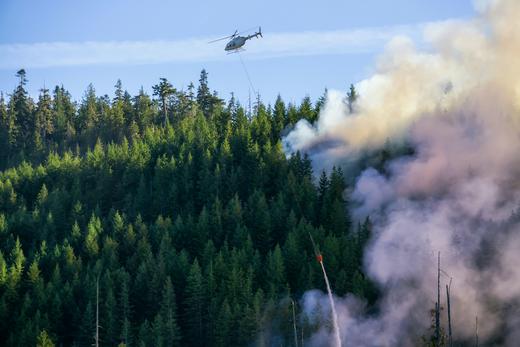Meaghan Weeden | July 7, 2022 | 4 min read
If you’re wondering why wildfires are getting worse, the answer might come as a surprise: although science shows that climate change is driving the increasing severity, over 90% of forest fires in the United States are caused by humans and many of them can be prevented.
While we’ve all heard about the gender reveal party that sparked the deadly El Dorado fire, many of our everyday activities can also ignite them. We may not be able to stop forest fires entirely because of each ecosystem’s unique fire ecology, but if you reside in an area that is prone to drought or forest fires, it’s important to follow forest safety guidelines to help prevent potential disasters.
How to prevent forest fires

1. Don’t Set Off Pyrotechnics
We get it: fireworks are as American as baseball and apple pie, and they sure are fun to set off. And gender reveal smoke bombs are all the rage these days, but in a hot and dry environment, they just aren’t worth the risk.

2. CAREFULLY DISPOSE OF SMOKING MATERIALS
Whenever you smoke, douse your butts with water and place in a fire-proof container to safely dispose of after you’re sure they’ve gone out. And whatever you do, don’t toss them on the ground.

3. CAMP RESPONSIBLY
Make sure the conditions are safe and that there isn’t a fire ban where you are — and never leave your campfire unattended. When you’re done, douse it and wait until it’s completely cold to the touch before leaving your campsite.

4. MOW THE LAWN BEFORE 10 A.M.
If you need to mow your lawn, the California Wildland Fire Coordinating Group recommends doing it early, before temperatures peak. But if it’s excessively windy and dry, wait for another day because the metal blades underneath your mower can easily spark a fire if they strike a rock.

5. MAKE SURE YOUR EXHAUST IS UP TO PAR
Check the exhaust of your vehicle, chainsaw, leaf blower, etc. to make sure they’re equipped with spark arrestors, which prevent engines from emitting flammable debris. And keep in mind that your exhaust can reach temperatures of 1,000+ degrees!

6. STAY ON THE ROAD
Off-roading is a blast, but it can have deadly consequences if done in grasslands or areas with heavy brush. Stick to gravel and asphalt, especially during dry seasons. In fact, the best time to off-road in fire-prone areas may be when the ground is saturated with rain or covered in snow.

7. Keep a Close Eye on Candles
Innocent though they may seem, candles are a leading cause of home fires. In fact, their flames can burn as hot as 1,400+ degrees! Your best bet? Place them into sturdy containers that can’t be knocked over, like mason jars. And never leave them unattended.

8. Create and Maintain Defensible Space
If you own your home, clear away any dead trees, brush, and vegetation within 100 ft. of all structures. This helps slow and/or stop the spread of wildfires within your community. It will also protect firefighters as they battle fires around your home.

9. LANDSCAPE FOR FIRE RESISTANCE
While you’re at it, incorporate fire-resistant plants like french lavender, sage, and California fuchsia and fire-retardant species like aloe, rockrose, and ice plant into your property. Take it one step further by creating fire-resistant zones with stone walls, patios, decks, etc.

10. Support Forest Fire Restoration
And finally, supporting forest fire restoration in areas that have experienced fires in the past is a key strategy for helping to prevent and/or reduce future fires. These projects, which are undertaken by conservation professionals, involve planting species that are native and fire-resistant.
